- Related articles
- What is PCI Express SSD?
- Difference between 1000BASE-SX and 1000BASE-LX
- How to Configure Settings for Dual NIC Deployments?
- What Is GYTY53 Fiber Optic Cable?
- Optical Transceivers for Cisco UCS-EP-MDS9148SL2 Switch
- Optical Transceivers for Cisco WS-C2960XR-48LPD-I Switch
- The Questions about the Cisco 10GBASE X2 Module & SFP Compatibility
- All Cisco CWDM-SFP-1610's information (List price, Specs, Datasheet PDF, Compatibility mat
- All Cisco SFP-GE-S's information (List price, Specs, Datasheet PDF, Compatibility matrix)
- Optical Transceivers for Cisco SF302-08PP-K9-EU Switch

Definition of TV Fiber Optic Cable
TV Fiber Optic Cable is the type of fiber optic cable which is used in connecting Television system. It mostly used to connect the TV to the high-speed data service industry. TV Fiber Optic Cable has drastically boosted the entertainment service industry through elements like broadcast television and on-demand video. Consequently, TV Fiber Optic Cable is used to deliver Television programming so as to paying subscribers through radio frequency signals transmitted via coaxial cables.

Design of TV Fiber Optic Cable
The original design of cable television systems was the one-way, analog transmission system using coaxial cable. Today, cable television companies have found that fiber is the perfect choice for transmitting signals to multiple customer locations. In this distribution system, each location is connected to an isolated terminal by a dedicated optical fiber and the tuner connected with each individual customer TV set is stationed in the remote terminal. Channel-selection signals are sent over the fiber from the customer location to the remote terminal. The single selected channel is the only channel transmitted over the fiber from the remote terminal to the associated TV set.
This application helps to prevent an outage for a large number of customers during a period of time and in turn, this gives the cable companies a better customer relationship. It also helps to increase the company's revenue by giving them a return path in which they can use for telephone connections and Internet. Because of the growth in demand for communication signal transmission, cable television is in the midst of advancing their existing systems with fiber optic technology.
Benefits of TV Fiber Optic Cable
With fiber optic technology, cable companies can offer their customers a much better quality picture while at the same time reduce their operating costs because fiber optics cost much less to maintain. One of the main uses of fiber optics to cable companies is the large information carrying capacity, which is hundreds of times greater than copper wire. Fiber optics also offers essential protection from electrical interference and lightning.
Fiber optics are highly reliable because they do not corrode in moisture, do not short out in water, and still perform at high speeds in any type of harsh weather. Optic cables are very lightweight because of their small size, and their long lengths make them easier to install. With fiber optic cables, there is no danger of fire hazards because they do not transfer any electricity.
Conclusion
Today, the TV Fiber Optic Cable is an important component in the entertainment industry that has brought great change. Many Television subscribers are enjoying effective radio frequencies. Many homes are now installing TV Fiber Optic Cable so as to better their Television connections.





































































